Animal cruelty is a grievous issue that often lurks in the shadows of society. It manifests not only in overt acts of violence but also in neglect, hoarding, and abandonment, all of which can go unreported due to fear of retaliation. This fear acts as a formidable barrier, rendering many individuals reluctant to intervene when they witness acts of cruelty. However, reporting such incidents is crucial for the protection of animals and the promotion of a humane society. Understanding how to report animal cruelty while maintaining anonymity is essential for concerned citizens who wish to take a stand against these injustices.
First and foremost, it is vital to recognize what constitutes animal cruelty. In many jurisdictions, animal cruelty is predominantly classified into two categories: active cruelty and passive neglect. Active cruelty involves direct physical harm, such as beating, torturing, or otherwise inflicting pain upon an animal. Passive neglect, on the other hand, pertains to situations where an animal’s basic needs are not met, such as inadequate food, water, shelter, or medical care. Recognizing these signs can be pivotal when deciding to lodge a report.
Observing animal cruelty can evoke a range of emotions, from anger to helplessness. The instinctual desire to intervene is often diluted by the possible consequences of reporting. Individuals may fear retribution from animal abusers, community ostracism, or the potential lack of immediate action from authorities. Such apprehensions are not unfounded, as numerous stories recount retaliatory acts against whistleblowers, highlighting the necessity for anonymous reporting options.
Fortunately, reporting animal cruelty does not have to come at the cost of one’s identity. Many organizations and authorities cater specifically to anonymous reporting. Local animal control agencies, humane societies, and even certain law enforcement bodies often provide mechanisms to report cruelty without revealing personal information. This system of anonymity is pivotal; it enables vigilant individuals to act assertively, fortified by the assurance that their identity will remain concealed.
To begin the process of reporting, one should first gather as much evidence as possible. This evidence may comprise photographs, video recordings, or detailed observations concerning the specific circumstances of the suspected cruelty. The more comprehensive the information you can provide—dates, times, locations, descriptions of the animals involved—the better equipped the authorities will be to take action. Retaining a record of these observations without revealing your identity is crucial; it fortifies your report, contributing to a stronger case.
After gathering evidence, the next step involves reaching out to an appropriate authority. Each jurisdiction has designated agencies responsible for animal welfare. Many of these entities have straightforward reporting systems that allow individuals to submit their concerns anonymously. It is advisable to visit the organization’s official website, where protocols for anonymous reporting are typically outlined. Some may utilize hotlines, while others may offer online submission forms. Each of these options serves to protect the identity of the informant while ensuring that vital information reaches the proper channels.
In addition to local agencies, there are national organizations dedicated to the enforcement of animal welfare laws. Groups such as the Humane Society of the United States (HSUS) or the ASPCA provide resources for concerned citizens wishing to report abuse. These organizations often have hotlines dedicated to receiving reports and will ensure confidentiality throughout the process. Engaging with these broader organizations may also afford a more significant platform for action against animal cruelty, as they may have greater influence over local governments and law enforcement agencies.
It is also essential to appreciate the broader implications of reporting animal cruelty beyond just the immediate situation. By acting on behalf of the voiceless, individuals not only contribute to the welfare of animals but also cultivate a more compassionate society. The visibility of reported incidents can spark community discussions about animal rights and welfare, engendering a culture that is resolute against cruelty. When more people report suspicious activities, it generates awareness and fosters an environment where abuse becomes less tolerated.
However, the responsibility does not cease at reporting; follow-up is equally vital. After an initial report, it may be beneficial to check in with the agency to ensure that the information was received and is being acted upon. While the resolution of such cases can take time, persistence demonstrates a commitment to the cause and increases the likelihood that authorities will prioritize the issue. Moreover, continued advocacy can inspire others in your community to take action, amplifying the collective voice against animal cruelty.
In conclusion, the movement against animal cruelty requires participation from conscientious individuals willing to report and advocate for better treatment of animals. Knowing how to report cruelty while remaining anonymous is an invaluable tool for those who wish to protect the innocent without fear of repercussions. By utilizing the resources available and fostering open discussions within communities, we can push back against the normalization of cruelty to animals. The fight against animal abuse is not solely the responsibility of organizations; it requires the vigilance and dedication of every individual willing to stand up for those who cannot speak for themselves.








